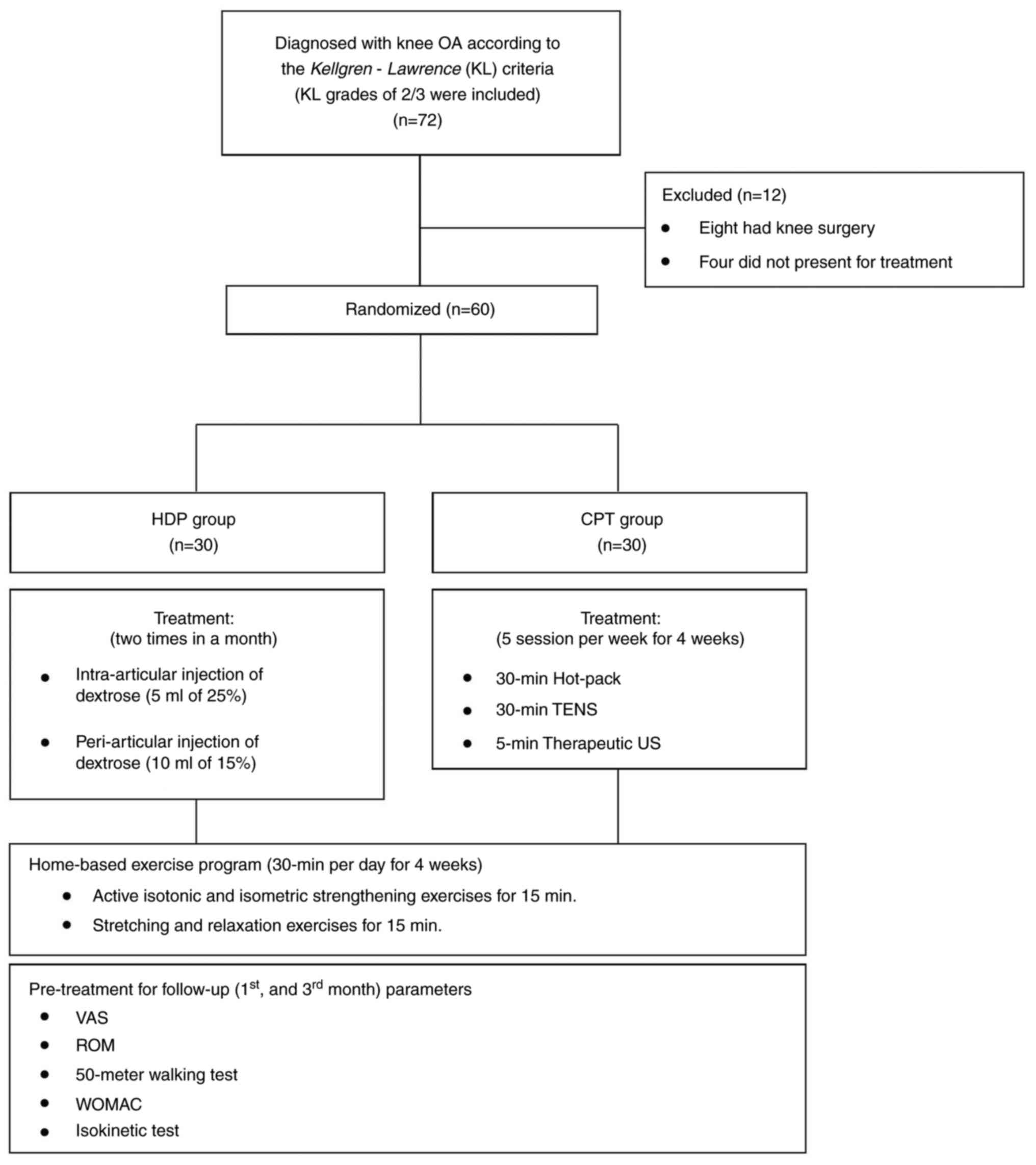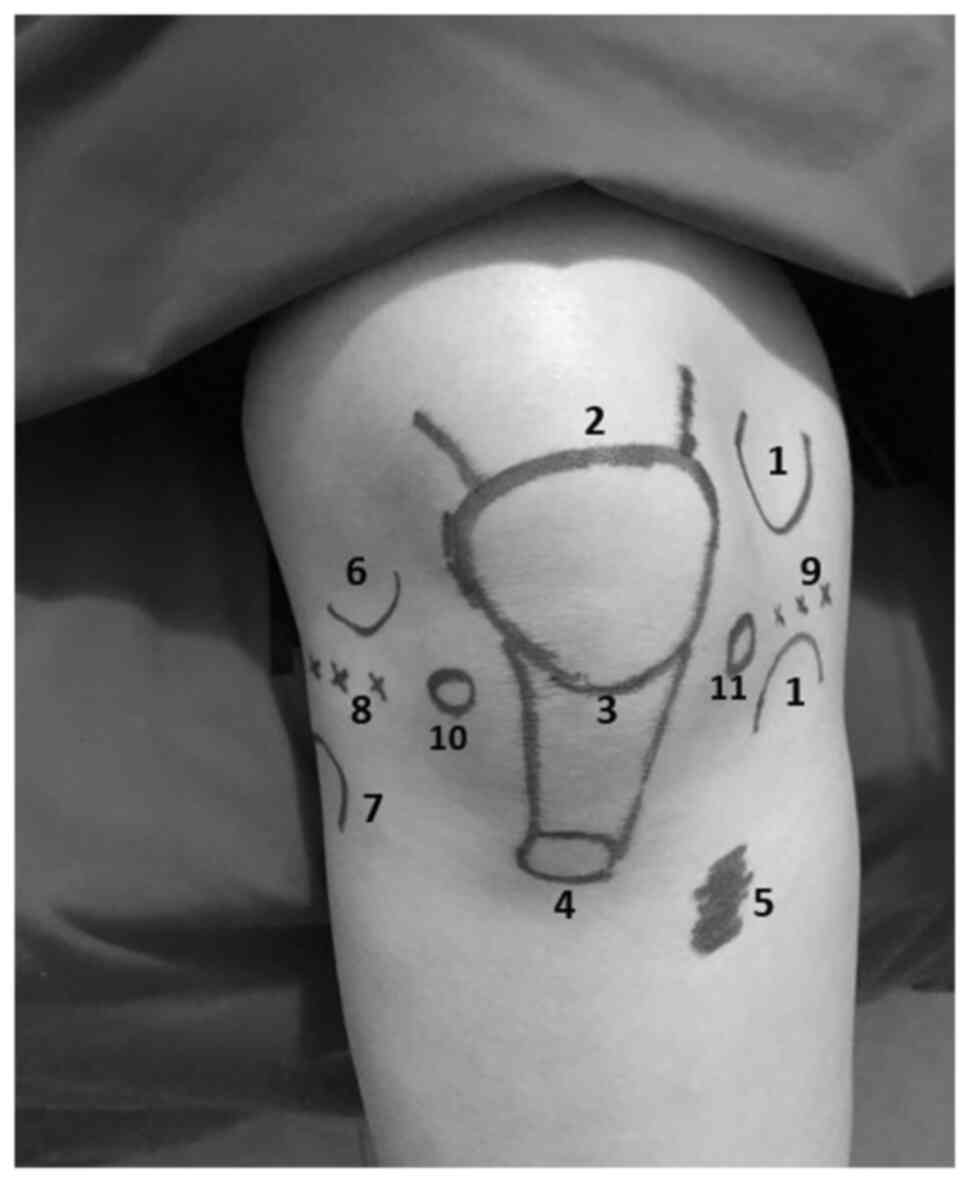|
1
|
Uysal A, Yildizgoren MT, Guler H and
Turhanoglu AD: Effects of radial extracorporeal shock wave therapy
on clinical variables and isokinetic performance in patients with
knee osteoarthritis: A prospective, randomized, single-blind, and
controlled trial. Int Orthop. 44:1311–1319. 2020.PubMed/NCBI View Article : Google Scholar
|
|
2
|
Wee TC, Neo EJR and Tan YL: Dextrose
prolotherapy in knee osteoarthritis: A systematic review and
meta-analysis. J Clin Orthop Trauma. 19:108–117. 2021.PubMed/NCBI View Article : Google Scholar
|
|
3
|
Kolasinski SL, Neogi T, Hochberg MC, Oatis
C, Guyatt G, Block J, Callahan L, Copenhaver C, Dodge C, Felson D,
et al: 2019 American College of rheumatology/arthritis foundation
guideline for the management of osteoarthritis of the Hand, Hip,
and Knee. Arthritis Care Res (Hoboken). 72:149–162. 2020.PubMed/NCBI View Article : Google Scholar
|
|
4
|
Öğüt H, Güler H, Yıldızgören MT, Velioğlu
O and Turhanoğlu AD: Does kinesiology taping improve muscle
strength and function in knee osteoarthritis? A single-blind,
Randomized and controlled study. Arch Rheumatol. 33:335–343.
2018.PubMed/NCBI View Article : Google Scholar
|
|
5
|
Basedow M, Runciman WB, March L and
Esterman A: Australians with osteoarthritis; the use of and beliefs
about complementary and alternative medicines. Complement Ther Clin
Pract. 20:237–242. 2014.PubMed/NCBI View Article : Google Scholar
|
|
6
|
Reeves KD, Sit RW and Rabago DP: Dextrose
prolotherapy: A narrative review of basic science, clinical
research, and best treatment recommendations. Phys Med Rehabil Clin
N Am. 27:783–823. 2016.PubMed/NCBI View Article : Google Scholar
|
|
7
|
Rabago D, Patterson JJ, Mundt M, Kijowski
R, Grettie J, Segal NA and Zgierska A: Dextrose prolotherapy for
knee osteoarthritis: A randomized controlled trial. Ann Fam Med.
11:229–237. 2013.PubMed/NCBI View
Article : Google Scholar
|
|
8
|
Reeves KD and Hassanein K: Randomized
prospective double-blind placebo-controlled study of dextrose
prolotherapy for knee osteoarthritis with or without ACL laxity.
Altern Ther Health Med. 6:68–74, 77-80. 2000.PubMed/NCBI
|
|
9
|
Rezasoltani Z, Taheri M, Mofrad MK and
Mohajerani SA: Periarticular dextrose prolotherapy instead of
intra-articular injection for pain and functional improvement in
knee osteoarthritis. J Pain Res. 10:1179–1187. 2017.PubMed/NCBI View Article : Google Scholar
|
|
10
|
Kohn MD, Sassoon AA and Fernando ND:
Classifications in Brief: Kellgren-Lawrence classification of
osteoarthritis. Clin Orthop Relat Res. 474:1886–1893.
2016.PubMed/NCBI View Article : Google Scholar
|
|
11
|
Roos EM, Klässbo M and Lohmander LS: WOMAC
osteoarthritis index. Reliability, validity, and responsiveness in
patients with arthroscopically assessed osteoarthritis. Western
Ontario and MacMaster Universities. Scand J Rheumatol. 28:210–215.
1999.PubMed/NCBI View Article : Google Scholar
|
|
12
|
Nguyen C, Lefèvre-Colau MM, Poiraudeau S
and Rannou F: Rehabilitation (exercise and strength training) and
osteoarthritis: A critical narrative review. Ann Phys Rehabil Med.
59:190–195. 2016.PubMed/NCBI View Article : Google Scholar
|
|
13
|
Brosseau L, Yonge KA, Robinson V, Marchand
S, Judd M, Wells G and Tugwell P: Thermotherapy for treatment of
osteoarthritis. Cochrane Database Syst Rev.
2003(CD004522)2003.PubMed/NCBI View Article : Google Scholar
|
|
14
|
Goh SL, Persson MSM, Stocks J, Hou Y, Lin
J, Hall MC, Doherty M and Zhang W: Efficacy and potential
determinants of exercise therapy in knee and hip osteoarthritis: A
systematic review and meta-analysis. Ann Phys Rehabil Med.
62:356–365. 2019.PubMed/NCBI View Article : Google Scholar
|
|
15
|
Soliman DMI, Sherif NM, Omar OH and El
Zohiery AK: Healing effects of prolotherapy in treatment of knee
osteoarthritis healing effects of prolotherapy in treatment of knee
osteoarthritis. Egyptian Rheumatol Rehab. 43:47–52. 2016.
|
|
16
|
Dumais R, Benoit C, Dumais A, Babin L,
Bordage R, de Arcos C, Allard J and Bélanger M: Effect of
regenerative injection therapy on function and pain in patients
with knee osteoarthritis: A randomized crossover study. Pain Med.
13:990–999. 2012.PubMed/NCBI View Article : Google Scholar
|
|
17
|
Rahimzadeh P, Imani F, Faiz SHR, Entezary
SR, Zamanabadi MN and Alebouyeh MR: The effects of injecting
intra-articular platelet-rich plasma or prolotherapy on pain score
and function in knee osteoarthritis. Clin Interv Aging. 13:73–79.
2018.PubMed/NCBI View Article : Google Scholar
|
|
18
|
Hassan F, Trebinjac S, Murrell WD and
Maffulli N: The effectiveness of prolotherapy in treating knee
osteoarthritis in adults: A systematic review. Br Med Bull.
122:91–108. 2017.PubMed/NCBI View Article : Google Scholar
|
|
19
|
Rabago D, Zgierska A, Fortney L, Kijowski
R, Mundt M, Ryan M, Grettie J and Patterson JJ: Hypertonic dextrose
injections (prolotherapy) for knee osteoarthritis: Results of a
single-arm uncontrolled study with 1-year follow-up. J Altern
Complement Med. 18:408–414. 2012.PubMed/NCBI View Article : Google Scholar
|
|
20
|
Wang J, Liang J, Yao J, Song HX, Yang XT,
Wu FC, Ye Y, Li JH and Wu T: Meta-analysis of clinical trials
focusing on hypertonic dextrose prolotherapy (HDP) for knee
osteoarthritis. Aging Clin Exp Res. 34:715–724. 2022.PubMed/NCBI View Article : Google Scholar
|
|
21
|
Arias-Vázquez PI, Tovilla-Zárate CA,
Legorreta-Ramírez BG, Burad Fonz W, Magaña-Ricardez D,
González-Castro TB, Juárez-Rojop IE and López-Narváez ML:
Prolotherapy for knee osteoarthritis using hypertonic dextrose vs
other interventional treatments: Systematic review of clinical
trials. Adv Rheumatol. 59(39)2019.PubMed/NCBI View Article : Google Scholar
|
|
22
|
Hsu C, Vu K and Borg-Stein J:
Prolotherapy: A narrative review of mechanisms, techniques, and
protocols, and evidence for common musculoskeletal conditions. Phys
Med Rehabil Clin N Am. 34:165–180. 2023.PubMed/NCBI View Article : Google Scholar
|
|
23
|
Han DS, Lee CH, Shieh YD, Chang CT, Li MH,
Chu YC, Wang JL, Chang KV, Lin SH and Chen CC: A role for substance
P and acid-sensing ion channel 1a in prolotherapy with
dextrose-mediated analgesia in a mouse model of chronic muscle
pain. Pain. 163:e622–e633. 2022.PubMed/NCBI View Article : Google Scholar
|
|
24
|
van Tittelboom V, Alemdaroglu-Gürbüz I,
Hanssen B, Heyrman L, Feys H, Desloovere K, Calders P and Van den
Broeck C: Reliability of isokinetic strength assessments of knee
and hip using the biodex system 4 dynamometer and associations with
functional strength in healthy children. Front Sports Act Living.
4(817216)2022.PubMed/NCBI View Article : Google Scholar
|
|
25
|
Şahin N, Baskent A, Ugurlu H and Berker E:
Isokinetic evaluation of both knee extensor/flexor muscle strength
in patients with hypermobility syndrome. Rheumatol Int. 28:643–648.
2008.PubMed/NCBI View Article : Google Scholar
|
|
26
|
Myers BJ: Isokinetic Testing of Muscle
Strength in Older Adults with Knee Osteoarthritis: An Integrative
Review. Isokin Exer Sci. 8:269–290. 2020.
|
|
27
|
Baert IAC, Meeus M, Mahmoudian A, Luyten
FP, Nijs J and Verschueren SMP: Do psychosocial factors predict
muscle strength, pain, or physical performance in patients with
knee osteoarthritis? J Clin Rheumatol. 23:308–316. 2017.PubMed/NCBI View Article : Google Scholar
|
|
28
|
Gür H, Cakin N, Akova B, Okay E and
Küçükoğlu S: Concentric versus combined concentric-eccentric
isokinetic training: Effects on functional capacity and symptoms in
patients with osteoarthrosis of the knee. Arch Phys Med Rehabil.
83:308–316. 2002.PubMed/NCBI View Article : Google Scholar
|
















